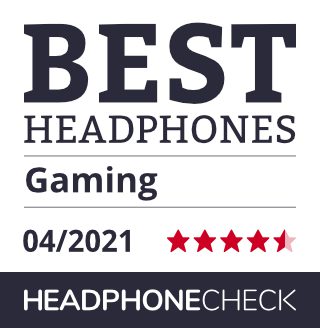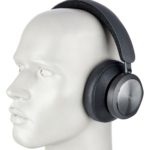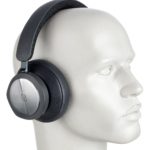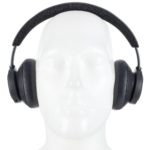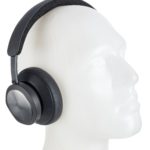With the Beoplay Portal, Bang & Olufsen has brought a remarkable pair of headphones onto the market. For they understand like no other manufacturer how to combine features such as “hi-fi”, “travel” and “gaming” into such a stylish concept. This is complemented by a choice of materials and manufacturing quality that leaves nothing to be desired. Bang & Olufsen have succeeded in this multi-platform approach – no question about it, and that merits sincere compliments. Nevertheless, they also have to face criticism: For example, the “headphones – app” was often awkward, the noise-cancelling could have been more effective for our taste and if you like to travel, there was simply no adequate transport protection.
After Bang & Olufsen announced a partnership with Microsoft in mid-2020 and specifically mentioned the US software giant’s Xbox gaming console, it was only a matter of time before we got the chance to wear a pair of gaming headphones from the Danish hi-fi specialist on our ears. Now the time has finally come: Beoplay Portal are here, and we shall see if they have what it takes to take the throne in the hotly contested gaming headset market. But will the result be Game Changer or Game Danger?

What can the Beoplay Portal do?
Before we go into detail, a few words of clarification are needed because Bang & Olufsen’s first headphones that are aimed specifically at gamers are not just a headset for this area of use.
The Portal have several interfaces: The headphones establish a high-bandwidth, low-latency connection with Microsoft’s game console via the Xbox wireless protocol, Bluetooth 5.1 with aptX Adaptive Codec, among others, is available for mobile devices, PCs are connected via USB-C and, finally, an analogue mini-jack connection ensures the integration of additional players such as DACs or other game consoles.
Adaptive noise cancelling and a transparency mode are among their core features – functions that have so far not really been associated with gaming headsets.
Package
The package surprised us a little. In addition to the Beoplay Portal, the manufacturer also provides an approx. 175 cm USB-C cable, an approx. 120 cm mini-jack cable and the usual written material such as the Quick Start Guide and safety instructions. But there is a total lack of an adequate transport bag to protect the Portal on our (soon to be resumed) travels. This is a real shame because if you spend almost 500 Euros on a pair of premium headphones, you want them to remain intact for as long as possible.
Design & workmanship
Here, the manufacturer must be given top marks because, as is typical for B&O, gamers can now join those who can put premium quality headphones on their heads. Our test sample came in black and anthracite (light grey and blue are also available), with a headband covered in lambskin, with breathable, knitted bamboo fibre padding and a notch in the middle to relieve pressure on the head. The aluminium rails, which extend as smoothly as butter, are embedded in the headband, and from that hangs the ear cups, which have all the controls and the soft ear pads made of lambskin. The two aluminium discs with the manufacturer’s logo on the outside of the ear cups not only have a very discreet anodised finish that reflects different colours depending on the amount of light, but also have touch functionality and respond to commands by being tapped.
Comfort
All these choices of design and materials made by the manufacturer result in a total weight of just 282 grams, which the headband distributes comfortably on the head so that we were able to wear the headphones for hours without any discomfort. This is also due to the contact pressure, which is firm but not too tight. The aluminium earpieces can be adjusted with millimetre precision thanks to their lack of ratcheting, and the soft lambskin pads with their memory foam filling not only have a conical shape they also become slightly thicker towards the bottom so that they rest on the jawbone and thus have a pressure-relieving effect. However, this results in an external noise attenuation that is somewhat in the mid-range.
Operation
As with other B&O headphones, the two aluminium surfaces on the earcups are used for control. If you tap twice quickly, playback is started or paused; during phone calls or video conferences, tapping twice ensures that the call is answered, while in Xbox mode, the audio playback is muted. That’s it for touch gestures; the rest is done using the built-in buttons and sliders.
On the back of the ear cups, you can find two strips on the left and right that are operated like sliders and allow you to change the volume (right) and to switch from transparency mode to noise cancelling (left) or in Xbox mode, setting the game chat balance. Two small, slightly raised dots each signal the end of the control range. In addition, the Portal also give an audible indication when the maximum control ranges are reached.
The two small buttons on the bottom of the ear cups are quickly explained: On the left, they switch between Bluetooth and Xbox mode; if you press the button for a few seconds, Xbox pairing becomes active. On the right, the small button is used to switch the headphones on and off, while pressing and holding it activates Bluetooth pairing.
All control gestures were always executed reliably and quickly; even the wildest “slider rides” did not cause the Portal to lose its balance.
However, we did feel that some control options were missing. For example, it is not possible to skip music tracks back and forth or even to fast-forward and rewind. It’s a pity, but in our opinion, B&O is missing out on important convenience features; as it is, you have to reach for your player if you want to change tracks.
Bluetooth
B&O have given the Portal Bluetooth version 5.1 and provide AAC and aptX Adaptive in addition to the minimum requirement codec SBC. The latter offers a dynamic compression rate of 5:1 to 10:1, can deliver up to 24 bits/48 kHz and has data rates of 276 kBits and 420 kBits. This gaming headset is also capable of multipoint: two devices can be connected to the headphones at the same time, while up to eight players can be added. As a result, the Portal automatically connects with the device that was last paired. If this is not found, the headphones scan the connection list for other partners.
The wireless link is relatively stable; inside rooms, the first dropouts only occurred after about 15 metres, while good values of almost 30 metres were achieved in open spaces.
Battery life
The manufacturer claims up to 12 hours of battery life when these headphones are used in gaming mode (Xbox Wireless, Bluetooth and ANC) and up to 24 hours when using Bluetooth with ANC switched on. When using Bluetooth only, the battery life increases to 32 hours. These are very good values, although they were not quite achieved in practice, as many factors such as volume or temperature play a not insignificant role. The lithium-ion battery has a capacity of 1,200 mAh, takes about three hours to recharge and can be replaced if necessary.
Noise cancellation and transparency mode
As mentioned above, this headset also offers Adaptive Noise Cancellation as well as a transparency mode – both rather atypical for gaming headphones.
But fortunately, these two “business features” are not just half-baked add-ons but deliver quite nicely.
To be fair, Bang and Olufsen’s noise-cancelling has never been able to match the effectiveness of a Sony WH-1000XM4 in the recent past, and neither can this new one. However, the noise cancellation works well, as low frequencies are neatly cancelled out, while high frequencies remain quieter but still perceptible.
The so-called diving bell effect is absent from this model, and – pleasingly – changes in the overall tuning of these headphones are hardly noticeable. Of course, a slight noise is audible, but this is due to the system and is not at all annoying, especially when the headphones are playing media content. The noise-cancelling can be adjusted between five levels, from subtle to high – either via the slider on the headphones or via the app.
The same applies to the transparency mode, which in its “Max” setting delivers somewhat overemphasised highs, noticeably raises the background noise but does not achieve the naturalness of a pair of Apple AirPods Max. Therefore, while we rate this function as good, it’s not quite perfect.
Connection required
In addition to wireless connection via Bluetooth, the Portal also has other connection options. The USB-C cable not only serves as a charging cable but also transmits audio. Accordingly, these headphones can be used as a USB headset with a computer, for example, including Dolby Atmos playback. This digital connection is also supposed to be possible on the Playstation 5 so that the headset can also be used almost completely here, including with ANC. However, due to the lack of a PS5, we were not able to check this.
In addition, there is also support for Xbox wireless mode, so that 2.4 GHz wireless technology can be used for wireless and low-latency gaming on the game console. This also works on Windows PCs but requires the Xbox wireless adapter, which can be purchased separately. However, Bluetooth audio is deactivated so as not to interfere with the wireless signal, while configuration via the app (via Bluetooth) remains possible.
Furthermore, the Portal can be connected with an analogue minijack cable. However, if you are happy that these headphones can continue to be used passively despite an empty battery, you might be rejoicing too soon because this operating mode also requires power. The advantage, however, is that this gaming headset now also provides all technical amenities such as noise-cancelling or control via touch or buttons – even on the Nintendo Switch or Sony Playstation. But, when these headphones are operated in this mode, they cannot be connected wirelessly to an Xbox or smartphone.
No other gaming headset currently offers such flexible connection options, and the manufacturer can only be praised here, but, as already mentioned above, there is one significant restriction: a simultaneous connection of Bluetooth and wireless, for example, to take calls on your Smartphone and continue playing on the Xbox in parallel, is not supported. But thanks to the numerous certifications (Google Fast Pair, Made for iPhone and Microsoft Swift Pair), pairing is very fast and always worked reliably in our tests.
Microphone
You won’t find a headset microphone on the Portal. Instead, the manufacturer uses a series of microphones that, thanks to beam forming, can isolate and amplify your voice and simultaneously suppress background noise. The voice quality was not crystal-clear, but it was acceptable to the extent that speech intelligibility was always assured. In addition, the “Own Voice” function detects the volume of the user’s own voice and filters out background noise. This is controlled via the left slider.
App
With the free app for iOS and Android, various settings can be edited. However, registration or logging in with your Facebook or Google account in advance is mandatory. Once this has been done, in addition to playback control (track forward and back, play, pause), specially adapted EQ settings are available, and these can be changed and saved. In the app, you can switch from ANC to transparency mode or change the assignment of the left slider. Firmware updates are, of course also possible, as is the management of other B&O products.
Tap the Xbox icon special, and EQ settings such as “FPS”, “RPG” or “Movie” become virtually available on the Portal. These settings can also be edited and saved. However, it is not possible to adjust on a grid as in Bluetooth mode; instead, a 5-band EQ is used.
As already mentioned, this headset supports virtual surround sound. To do this, you can download the Dolby Access app from the Microsoft App Store, register the Portal and then receive a licence valid for life.
Unfortunately, the link between the headphones and the app did not always work smoothly in our test, which took place over several weeks. Time and again, the app – whether on iOS or Android – reported that the headphones could not be found despite the Bluetooth connection. The only solution was to manually switch the Portal off and on again. The track control in the iOS app was also not working properly, which meant that we could press play, but the pause command was consistently ignored. A forced disconnection also helped here. We would like to see the B&O pest controller here so that we can also pin an award on the lapel of the Portal in terms of “integration”.
Sound
If you enjoy the sound signature of other Bang and Olufsen headphones, you will also enjoy the Portal. The warm foundation gives a crisp and tight bass, while the midrange builds on it and is harmonious and well-balanced without pushing itself to the fore. In the upper registers, the Portal is just as confident. Even high-frequency material is reproduced without any real sharpness, which predestines these headphones for hours of fatigue-free listening. Although the Portal, with its integrated DSP, does not always achieve the airiness and openness of an open headphone system, movements in the sound field can always be tracked and enable accurate localisation. Due to the closed system, “listening in-depth” is more limited than it would be with open headphones. Nevertheless, with the Portal, Bang & Olufsen once again show how well their sound tuning works across genres. Deepened electronica tracks are just as impressively reproduced by these headphones as playful jazz or brutal metal pieces. And what my colleague said in our review of the Beoplay HX also applies to the Portal: “a great listening experience no matter what genre you’re listening to” – that sums it up quite well.
In gaming mode, the Portal also show their best side, especially if Dolby Atmos has been successfully installed. Footsteps, gunshots or explosions can be reliably located in the virtual surround field. Compared to pure stereo headsets, gamers have a clear advantage. Absolute hardcore gamers might miss a certain “thump” if these headphones don’t give them the required bang, but they can still adjust the equaliser and configure and save their settings accordingly.
Technical specifications
- Ear couplingOver-ear
- Typeclosed
- Transducer principledynamic
- Frequency response (headphones)20 - 22.000 Hz
- Impedance +/- 15%: 24 ohms
- Sound pressure level (SPL)1 mW @1kHz: 95 dB
- Weight with cable292 g
- Weight without cable282 g
- Cable length120 cm
What's in the box
- Mini jack cable
- USB-A to USB-C cable
Special features
- available in black/anthracite, light grey (Grey Mist) and blue (Navy)
- BT codecs: SBC, AAC, aptX Adaptive
- BT version: 5.1
- Dolby Atmos licence











